 Thanks: 0
Thanks: 0
 Likes: 0
Likes: 0
 Needs Pictures: 0
Needs Pictures: 0
 Picture(s) thanks: 0
Picture(s) thanks: 0
Results 1 to 9 of 9
Thread: Changes/lessons from storerboats
-
30th March 2009, 11:06 AM #1
 Changes/lessons from storerboats
Changes/lessons from storerboats
This was part of a discussion on the Woodenboat forum,
Howdy Canoez, Originally Posted by Canoez;
Originally Posted by Canoez;
Usually there is not much change needed for the hullshape in terms of performance. The hulls I design are pretty moderate in terms of the basic, but often there are little detail things I change over time on feedback from builders.
So far (touch wood) all my designs have worked pretty well, have balanced and performed fine or better.
In a couple of cases I have had a chance to do a little tweaking with a MK2 version of a design. Examples are ...
1/ My BETH sailing canoe .. I built this from a sketch and was computerised and modified when I started my boat design career ...
So when I computerised it (creating a Mk2 version that is in all the plans) I used my sketch as input but from a couple of years of sailing BETH I knew she had one flaw I wanted to get rid of.career noun 1 one's professional life; one's progress in one's job. 2 a job, occupation or profession. 3 one's progress through life generally. 4 a swift or headlong course. verb (careered, careering) intrans to rush in an uncontrolled or headlong way.
ETYMOLOGY: 16c: from French carrière racecourse, from Latin carriara carriage road, from carrus wagon.
http://www.storerboatplans.com/Beth/beth.html
Because of the very light displacement on such a long boat and the flat bottom she is not very deep in the water at all ... sometimes you could see right underneath her in particular lengths of chop. When the water "dropped away" like this it made very loud and inappropriate sucking sounds! I have had people STARE at me - you try explaining it is the boat!
Part of the problem was that the width of the boat had a sudden tweak near each end creating a near parallel midbody, I smoothed the tweak at the front end out for a smoother transition into the body of the boat and that reduced the noxious noises.

My original BETH
The problem was caused because of her origins ... I wanted to reflect the deck shape of an 1870s American sailing canoe ...

from a wonderful resource http://dragonflycanoe.com/stephens/
All in all, the squareboat canoe BETH worked well in every way except for that one "defect". So as there was a chance to do something about it I did.

You can see the kink still is there in the tail end, but the front end has been smoothed out.
2/Raceboard. A fair few years ago I designed a raceboard (racing windsurfer) in collaboration with a veteran racer of the beesties (Menno Van Doorn). We had decided three things ... that carbon manufactured boards were too expensive ($4000 at the time) and heavy (15kg) and counter to the continued participation of people in the sport. And they were not particularly durable either.
A ply raceboard came out at $400 and weighed in at 12kg. It was durable too as it went through 6 seasons before it was destroyed in a bushfire (Menno lost his house but was worried about what I would think about the board - a really nice chap!)
Also it was a time when all the manufacturers were touting the advantages of different concavities on the bottom of the board. Sailors in general know that concavities are draggy and counterproductive so we had a flat bottom going into a slight vee. This is now pretty much the standard for sailboards and surfboards though there are recent signs of some reversion to concavities.
Anyway .. the board was more than capable of racing week in and week out with Menno's local fleet.

The DOWNSIDE of the design, is that racing longboards have to get their noses up when reaching to reduce wetted area. This board did not do it as easily as most. The problem was only tiny ... it just needed 6mm of rocker in the back end to get the nose up.
3/ This same effect is there "in droves" with the OZ PDRacer with its Bolger inspired rocker well back in the hull. I could not change the rocker much because the class rules preclude it. After sailing our Mk1 PDRs which used the class tolerances to strip a bit of the displacement out of the hull by flattening the rocker, we found the boats had a very strong tendency to stick their noses in the air at higher speeds.

This is a virtue in some senses because it means if the boat is trucking along that big flat bow tends to be well above the waves.
But it was a bit much of a tendency reaching. So I redid the rocker as much as I could to help keep the bow a little lower. It does a little, so I think the Mk2 boats will have a little advantage over the the two Mk1 OZ boats that we originally built.
Careful observation of strangely shaped PDRacer has taught me a very great deal about using the dynamics of the hull to improve handling and safety of a particular boat. And the PDRacer has a lot of highly improbably features as a given ... so it is a hugely interesting process to see what can be worked out with detail design and lots of hard sailing in different conditions and to look at the results objectively with the question "what can I learn from this boat".
In conclusion, it can be a huge job to modify an existing design with many drawings changed and recompiling the plans to contain the new illustrations. So I don't do it lightly. But when there is an opportunity to do so .. I usually will
RAID41
With the RAID41 I wanted to make the boat handle a bit more easily and safely in rough water so pushed the rocker back a little to help keep the bow out when the boat is going quickly. It will trim a little off the top speed, but that is a good choice with the projected use of the boat. There are a couple of other tweaks in there to get the same behaviour, so this is not the only factor.
Best wishes
Michael Storer
-
30th March 2009 11:06 AM # ADSGoogle Adsense Advertisement
- Join Date
- Always
- Location
- Advertising world
- Age
- 2010
- Posts
- Many
-
30th March 2009, 01:36 PM #2
 Senior Member
Senior Member











- Join Date
- Jul 2006
- Location
- Portland, Oregon, USA
- Posts
- 334

Mik,
Fascinating stuff.
-
31st March 2009, 10:41 AM #3
 SENIOR MEMBER
SENIOR MEMBER











- Join Date
- Sep 2007
- Location
- Savannah GA USA
- Posts
- 583

I believe I came across something somewhere (on your website?) that stated you had reduced the rocker a little in the GIS.
Could you comment? (when and how much)
-
31st March 2009, 01:06 PM #4

Howdy BobWes,
I think that was from the design process way back before the first one was built.
I wouldn't want to change much on the Goat at all - I am pretty happy with every aspect of it. There appear to be no vices in any wind conditions and the boat just flies.
With regard to rocker specifically, did you see how MAM's floated as a rowboat? Just perfect like on the drawing.
The only thing I wanted to change was the weight of the mainmast and we have covered that with the square hollow and now the birdsmouth versions.
Michael
-
31st March 2009, 01:45 PM #5
 SENIOR MEMBER
SENIOR MEMBER











- Join Date
- Sep 2007
- Location
- Savannah GA USA
- Posts
- 583

Here's what MIK is talking about:

I weigh 230 bare assed naked and probably 235 as seen here. The Goat is right on her lines--bow and transom clear of the surface with a little more clearance forward.
But what about the rocker changing, MIK? What would be different if this was Gruff I was rowing?
-
31st March 2009, 02:42 PM #6

Howdy,
Gruff is exactly the same. The changes were on paper before any boats were built.
MIK
-
31st March 2009, 08:06 PM #7
-
5th April 2009, 06:05 PM #8

Re: Flipping Loon
Howdy,
Interesting comments about curved sides, flare etc. People do tend to like
them.
But it is not necessarily proved they will improve the performance of a boat.
Often conventional ways of doing things are just that .. conventional .. and
nobody has ever tested in a systematic way.
I have had a lot of arguments on the net over the years because I don't think
that if something "looks good" it will also be the best technical solution.
ie, that aesthetics and technical requirements for performance etc are
completely separate.
I would like to think that technical requirements are more or less a universal
solution .. that will work at any time or any place.
And Aesthetics are almost completely separate and completely driven by fashion.
In one way I think that round hulls and flare come from the shape of trees ...
if our trees were square I would not be surprised if we were all sailing square
boats and everyone would be shocked and think about the "wrongness" of round
shaped flared hulls. I am not serious about this ... but it is fun to think
about it.
At every stage of racing boat development everyone says how ugly the new boat
style is and how nobody but racers will be interested in such boats .. but sure
enough ... cruisers and general boat design follow quickly in train and then are
equally upset when there is some future evolution, which is decried, then
accepted.
Big cycle.
This is one of my favourite designs, John Illingworth's Myth of Malham from the late '40s, it was very light (for the time), very narrow and very deep and carried a lot of sail. The traditionalists all said she was a Machine .. not a sailboat.
Or RAGTIME .. from NZ designer John Spencer ... near sisterships were banned from Australian sailing because it was plywood and "not a proper boat" and "dangerously lightly built" ... um ... 50 years ago!!! Much modified keel and rudder, but look how sweet that hull is. Holder of many race records. The real reason for banning ... maybe the people with existing boats were afraid of these much faster, potentially amateur buildable boats. The fun thing ... is that the people who banned the ply boats were the same that supported the radical Myth of Malham only 15 years earlier.

Anyway ... not important .. but something I like to think about.
Michael
 Originally Posted by DennisMingear
Actually Denny ... hehehe
Originally Posted by DennisMingear
Actually Denny ... hehehe Originally Posted by our_own_ David Graybeal
Originally Posted by our_own_ David Graybeal
Enjoyed your thinking on this too.
One nice thing that this separation of aesthetics and technical requirements
means is ...
You can achieve both ... because they are more or less independent variables!!!
If they have a strong relationship it means one will force the other into
particular directions.
If independent, the technical side can be answered, but there is considerable freedom on
the aesthetic side. Most of the aesthetics is highly fashion based ... so I
tend to go back to tradition a fair bit ... particularly sheerlines and after
that the sailplan ... just to get the various curves and angles looking nice.
But only after settling the technical requirement!

Though sometimes with BETH everything came together ... I had a number of
technical requirements that I wanted to try,
Narrow, light canoe hull to enable roofracking
Box cross section
Conventional dinghy deck
Making a traditional sailplan go fast upwind and down
Good foils
Tiny rudder
Much more sail than the average canoe.

And then it all came together when I saw some pics of 1870's sailing canoes.
Suddenly the Aesthetic overlay for the technical package became obvious.
Without those pictures the result might have been quite different.
For example ... it would be easy to make Beth "plug-ugly" without compromising the sailing performance at all.
So ... you could say Art and Science .... but maybe it is getting the science
right and getting the art right.
MIK
-
5th April 2009, 09:30 PM #9
 SENIOR MEMBER
SENIOR MEMBER











- Join Date
- May 2008
- Location
- UK
- Posts
- 848

Here is Water Rat, 14' x 5' 8", from 1898

This illustration is from "John Leather , Spritsails and Lugsails"
It shows Water Rat designed and built by F Thompson in 1898, and raced in her local Southampton Sailing Club with success.
Quote
"She was a good all round boat, and a consistent performer, reaching faster than her competitors and always amongst the leaders. However the design was resented by the remainder of the restricted class who considered it too radical a departure from contemporary British practice. The Water Rat was probably the most interesting sailing dinghy which had then been built."
Brian
Similar Threads
-
Goat Island Skiff - Tools (AND CLAMPS) required? Applies to all storerboats
By rsycre7171 in forum Michael Storer Wooden Boat PlansReplies: 21Last Post: 22nd September 2009, 08:27 PM -
Looking for Lessons
By Billyboydes in forum WOODTURNING - GENERALReplies: 10Last Post: 4th January 2008, 06:48 PM -
Lessons
By DIY DAN in forum WOODTURNING - GENERALReplies: 3Last Post: 12th February 2007, 11:25 AM -
lessons
By nugit in forum WOODWORK - GENERALReplies: 2Last Post: 26th May 2000, 02:46 AM




 Reply With Quote
Reply With Quote

